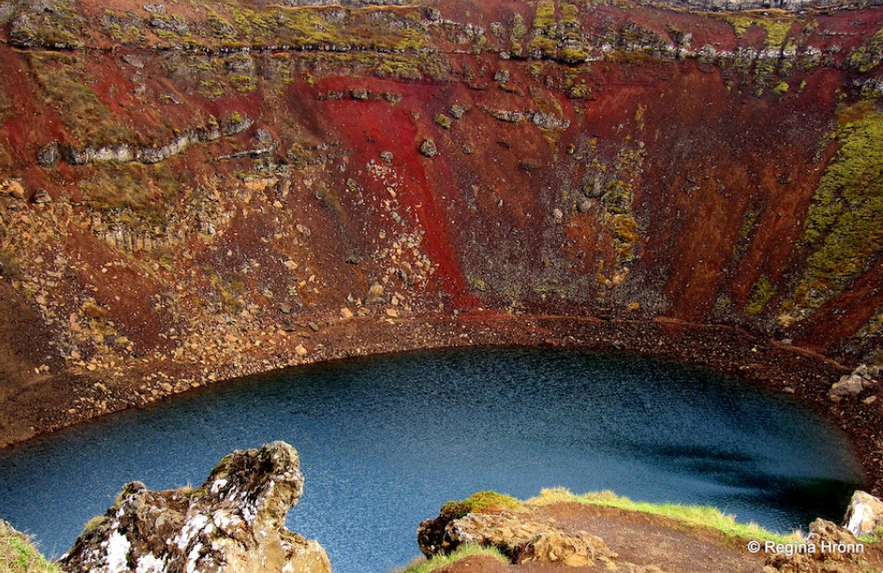
Kerið crater and Nykurinn - the Water-kelpie in South Iceland

Folklore is connected to the lake in the crater which tells us about a water kelpie living in the lake.
In this travel-blog I am going to tell you a little bit about the craters, the water kelpie, and the settlers of this area in South Iceland.
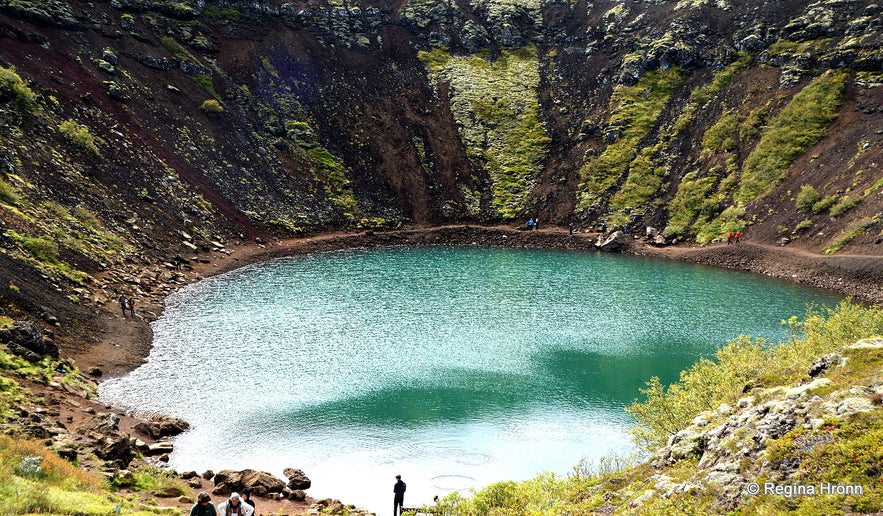 Kerið crater
Kerið crater
Kerið crater is the northern end of a row of craters, called the Tjarnarhólar craters, but they are russet to bright red in colour.
The beautiful russet-coloured Kerið crater is approximately 170 meters wide, 270 meters long, and 55 meters deep and the water level of the lake in the middle of the crater varies somewhere between 7-14 meters.
 By Kerið in 2010
By Kerið in 2010
The crater is privately owned and the owners charge an admittance fee of ISK 400 so that they can maintain and secure the surroundings of the crater.
Once, when there was no maintenance by Kerið I slid on the loose grave on the rim of the crater and could easily have fallen in, so let's be careful here.
It is a good thing that the area is maintained, as there are so many visitors and we must keep them safe here by the volcanic crater. But, on the other hand, we Icelanders tend to stop visiting places in nature in our country where an entrance fee is charged.
 Visitors paying the entrance fee to Kerið
Visitors paying the entrance fee to Kerið
We used to stop often at Kerið and have a picnic by the crater, as the surroundings are fairytale-like especially when you are here alone.
But times have changed and now there are a lot of visitors here, as Kerið crater is now a part of the Golden Circle, the most popular day tour in Iceland.
I only visit Kerið now when I join Golden Circle Tours which include the entrance fee to Kerið.
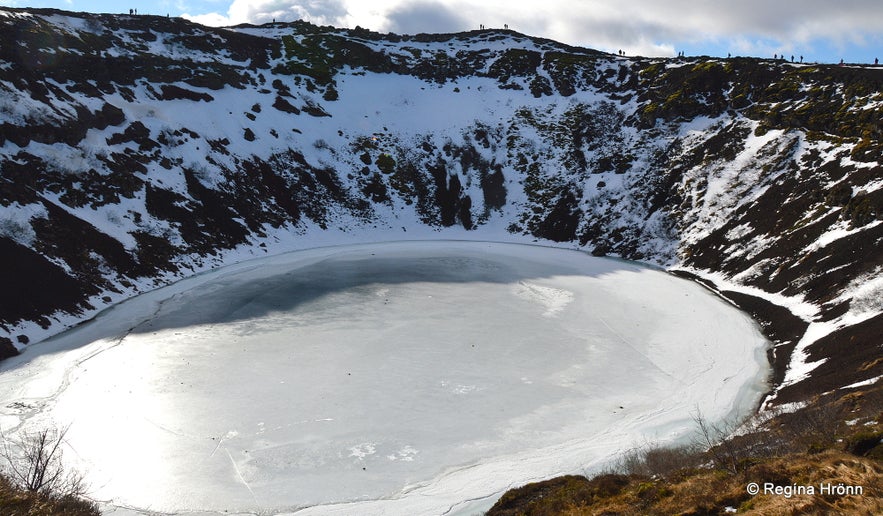 Kerið in March
Kerið in March
We used to think that Kerið was an explosion crater, but no ash deposits have been found to support that theory. So now it is believed to be a scoria crater.
It seems that the crater was formed when a small magma chamber beneath the crater was emptied by the end of the volcanic eruption and then collapsed.
The information sign by Kerið explains this procedure in greater detail with drawings.
And on the information sign, we read that approximately half of the lava in the Tjarnarhólahraun lava field flowed from Kerið, or 11.9 km2.
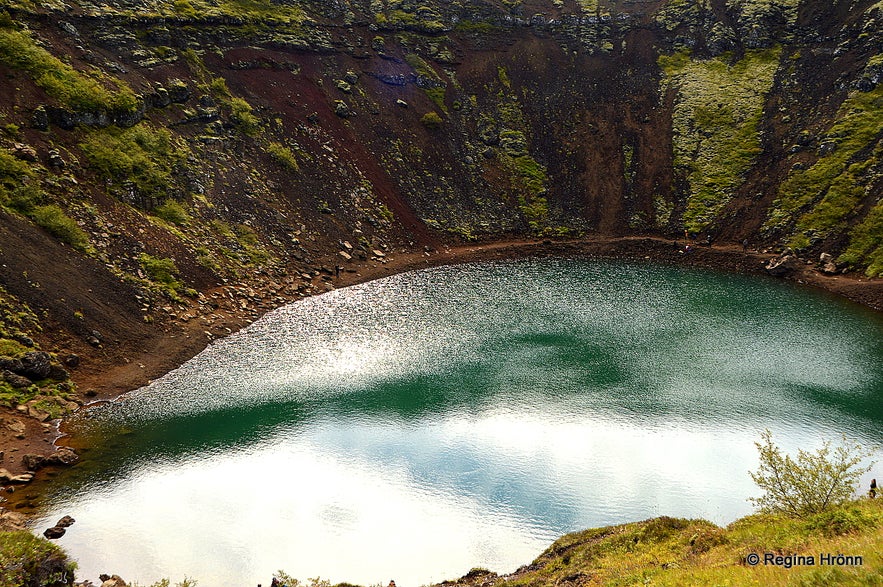 Kerið in August
Kerið in August
Kerið crater looks like an amphitheater and there are great acoustics here. In August 1987 a concert was held in the middle of the lake of Kerið crater.
And again in 2004. Here you can see a photo from the 2004 concert - my cousin Kjartan is playing in the middle of the crater.
2,000-3,000 people attended the concert and we were lucky that there was a heatwave in Iceland and it was sunny and over 20 degrees C on the day of the concert.
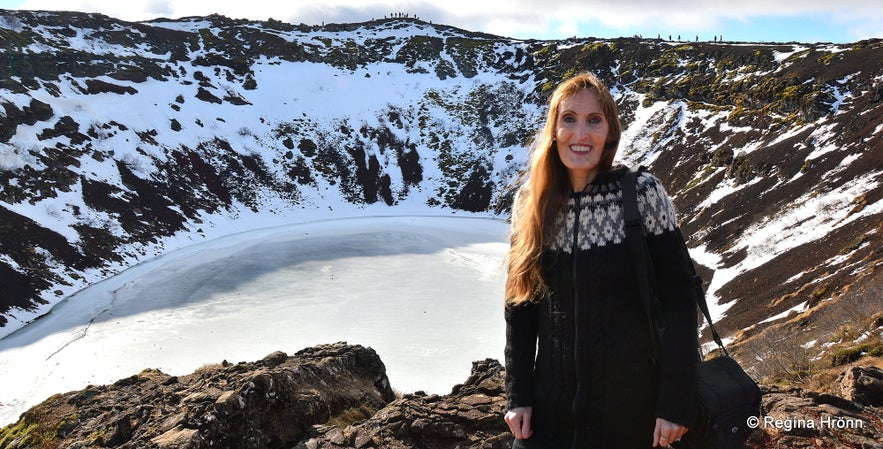 Visiting Kerið in March on a Golden Circle tour
Visiting Kerið in March on a Golden Circle tour
The concerts were held again in 2005 to support the rescue team Björg from Eyrarbakki village close by. And since then several concerts have been held in Kerið crater.
The folklore about the nykur - water kelpie in Kerið and Mt. Búrfell
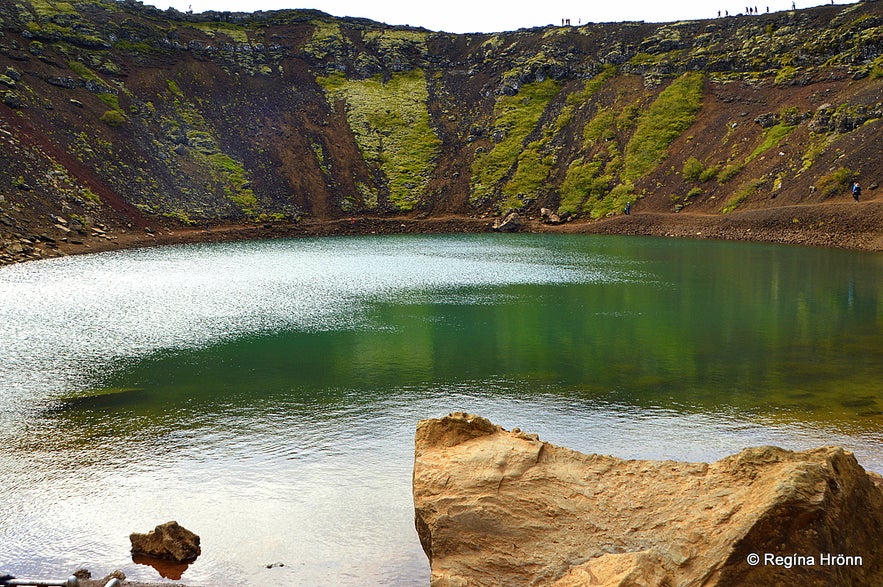 Kerið crater in August
Kerið crater in August
Icelandic folklore tells us that there is a connection between Kerið volcanic crater and Mt. Búrfell, a tunnel or tunnels.
Mt. Búrfell, which is close by, is a tuff mountain (534 m) with a water-filled crater.
There is an old belief that when the water level in Kerið rises then it decreases in the lake on top of Mt. Búrfell - and vice-versa.
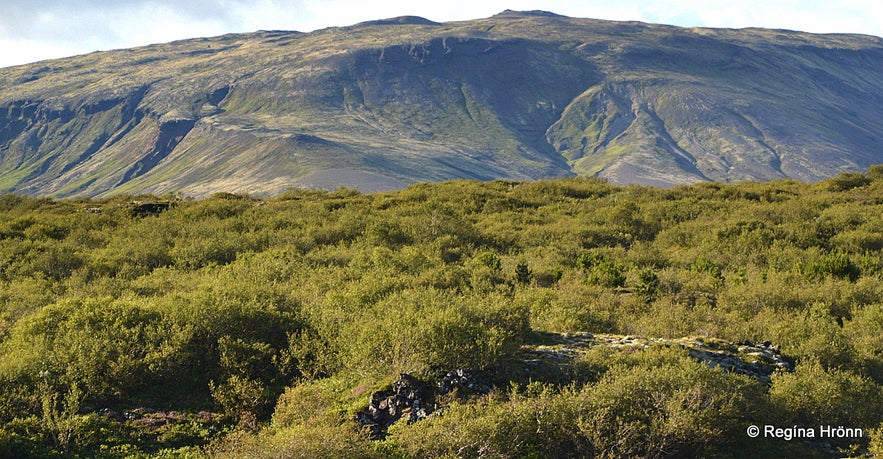 Mt. Búrfell in Grímsnes
Mt. Búrfell in Grímsnes
The more boring fact is that there is no outlet from the lake in Kerið crater.
When I was maybe 11-12 years old and having a picnic with my uncle's family by the lake in Kerið, I remember seeing fish in the lake. Where did they come from?
The story goes that a water kelpie - nykur in Icelandic, lives in the lake in Mt. Búrfell and travels through the tunnels.
 Here you can see the distance that the water kelpie travels from Kerið to Mt. Búrfell (taken at night)
Here you can see the distance that the water kelpie travels from Kerið to Mt. Búrfell (taken at night)
I have also heard that the farmers of Búrfell believed that Kerið was bottomless and the water kelpie stayed for one year in the lake at Mt. Búrfell and one year in Kerið crater.
A water kelpie is described as a gray horse (sometimes brown) with reversed hoofs, fetlocks, and ears.
And it is supposed to have a blister on its left side. If you manage to burst the blister it will become tame.
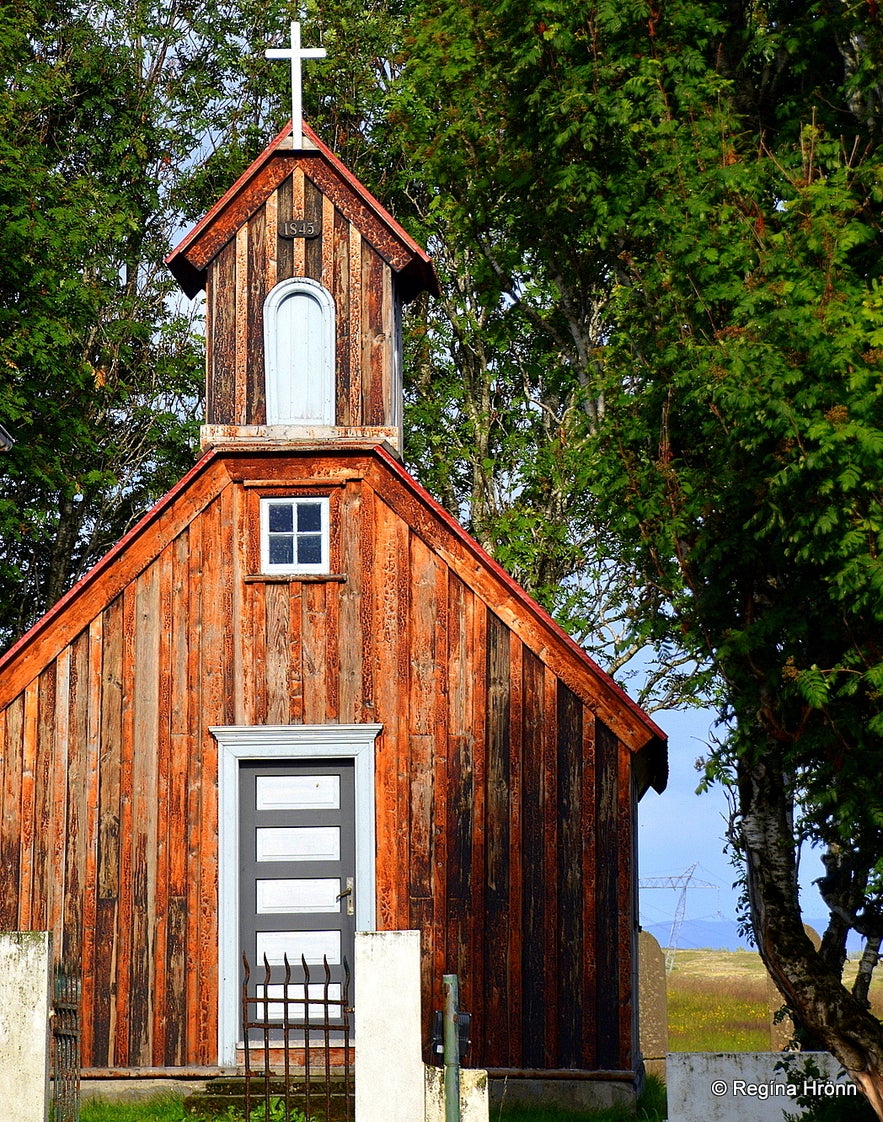 Búrfellskirkja church by Mt. Búrfell
Búrfellskirkja church by Mt. Búrfell
The water kelpie tries to lure people into sitting on its back with the intention of dragging them into the abyss!
If people fall for its scheme they seem to get stuck to its hide and the water kelpie runs towards either the lake in the crater of Mt. Búrfell or the crater in Kerið.
It then jumps into the lake and drowns the rider. Why I don't know.
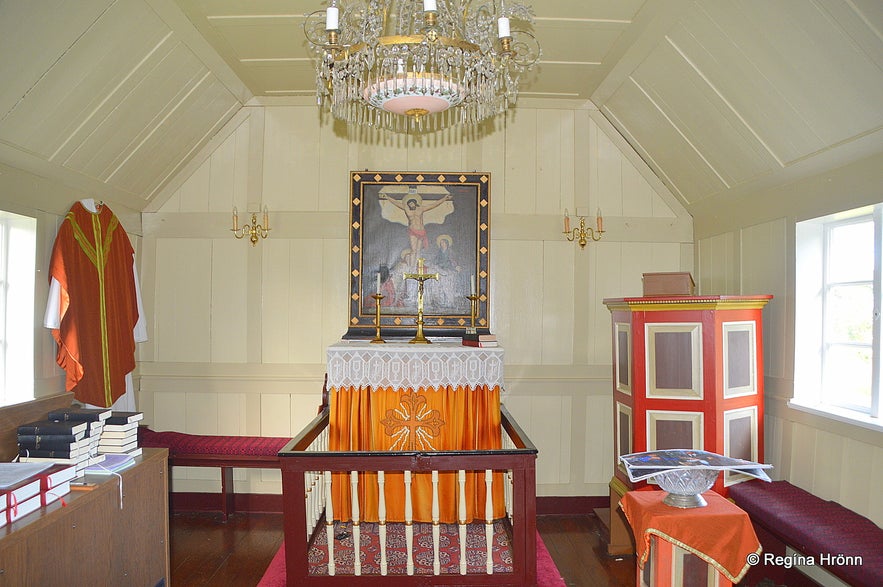 Inside Búrfellskirkja church by Mt. Búrfell
Inside Búrfellskirkja church by Mt. Búrfell
If you meet a water kelpie make a sign of the cross and it will either disappear into the ground or frantically run towards its lake.
It is believed that the old custom of making a sign of the cross above the horses before mounting them stems from this belief.
Also if the water kelpie hears the sound of a bell it will disappear into the ground. (Ref. Íslenskar þjóðsögur I, page 152 - Ólafur Davíðsson).
You can tell that it is not a good Christian horse, but has evil intentions.
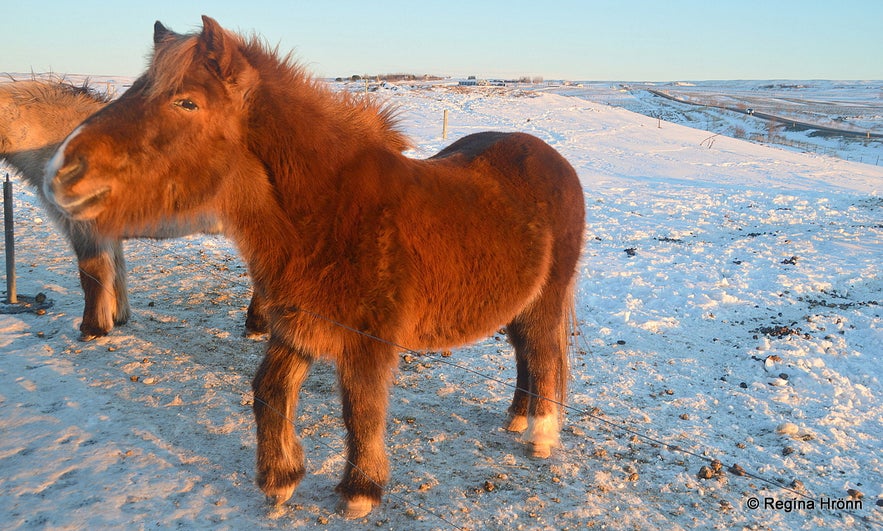 This is not a water kelpie, only an Icelandic horse in its winter clothing - you can tell by the hoofs and ears
This is not a water kelpie, only an Icelandic horse in its winter clothing - you can tell by the hoofs and ears
Many people can sit on a water kelpie's back as it can increase in size.
In Þjóðsögur Jóns Árnasonar - the Collection of folklore by Jón Árnason volume III (pages 207-212), there are many stories about water kelpies, including a story about many children mounting a water kelpie.
The last child who was about the mount the water kelpie made the sign of the cross on the water kelpie and was saved, but the water kelpie ran towards the lake with the other children and they all drowned :(
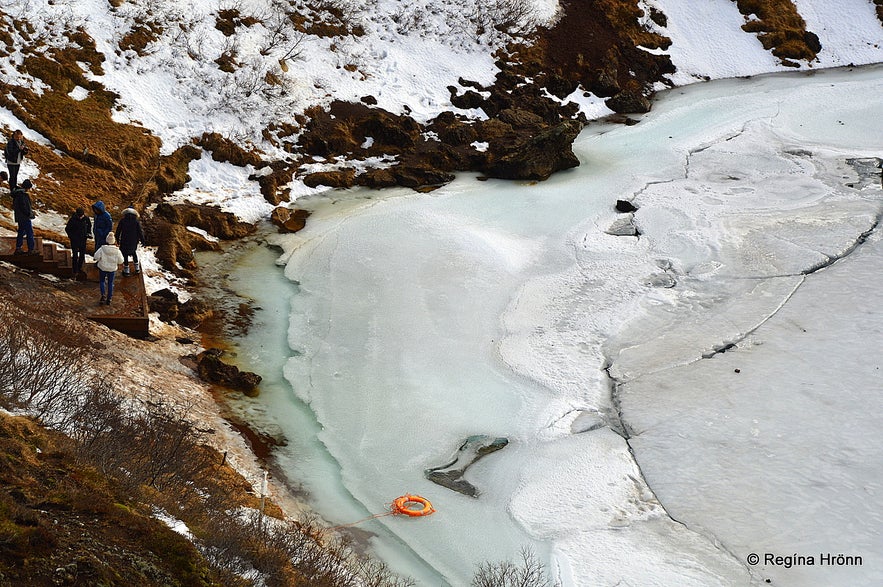 People down by the lake in Kerið in the wintertime
People down by the lake in Kerið in the wintertime
So if you see a gray horse with reverse hoofs and ears, run in the other direction, especially if there is a lake close by, and by no means mount it!
Or if you want to scare it away, try calling its name Nykur or Nennir, as it seems to hate its name and jumps into the lake when it hears it.
That is rather convenient as the Icelandic word "nenna" means to bother with and some people have been saved by saying by chance: "Ég nenni ekki..." - meaning "I cannot be bothered with..." and the water kelpie ran away.
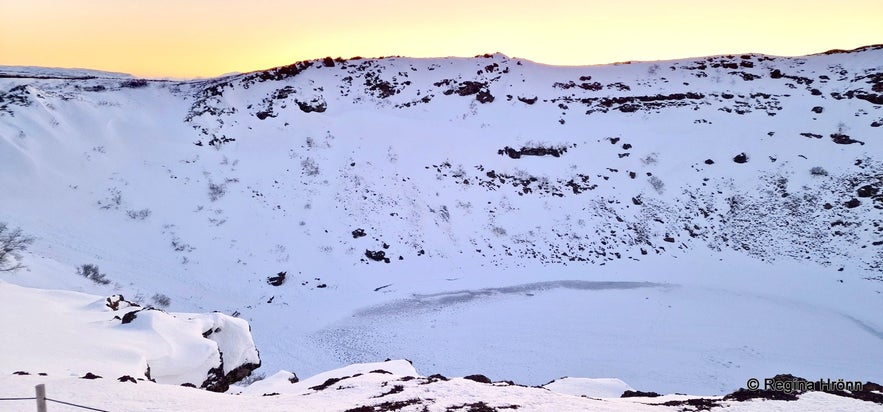 Kerið at sunrise in January
Kerið at sunrise in January
It seems to do the same if you call it by any name beginning with an "n", like Nóni.
It is also called Vatnaskratti in Icelandic which means water devil, and Skolli - the Devil, it runs away if it hears the name of the devil. I have also read that it runs away if it hears the name of Jesus and God.
But then you have to be aware of the fact that you are dealing with a water kelpie and not a normal horse, so know the telltale signs; reversed hoofs and ears.
Another name for a water kelpie in Icelandic apart from nykur is kumbur and we have a Kumburtjörn pond and Mt. Kumburtjarnarfjall in South Iceland.

Cracks in the ice at Kerið
Cracks can sometimes be seen and heard in the ice on the lakes where water kelpies live due to the movement of water kelpies beneath the ice.
And when water kelpies move location and travel through the tunnels there is a lot of commotion.
Nykur - the water kelpie is found in folklore in other countries, f.ex. in the northern countries, on the Orkney islands, and in Celtic folklore, so it is only normal that it found its way into Icelandic folklore, seeing that our origins lie in Norway and in Ireland.
I would love to visit the Helix home of the Kelpies in Scotland where you can see huge statues of water kelpies.
 By Kerið on a Golden Circle tour in August
By Kerið on a Golden Circle tour in August
Water kelpies have been seen both in lakes and rivers and occasionally even in the sea and there are surprisingly many stories about water kelpies in Iceland.
I found a story about a water kelpie in Lake Hestvatn in Grímsnes in Íslenskar Þjóðsögur by Ólafur Davíðsson volume I, page 153.
In that short story, just a short mention really about this place, it is said that the water kelpie lives for 20 years in the lake on Mt. Búrfell and 20 years in Lake Hestvatn.
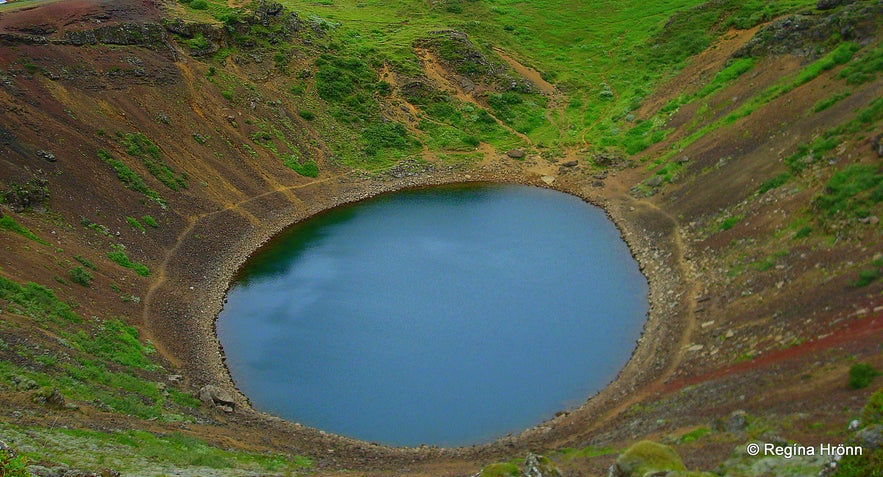 The oval-shaped Kerið in 2010
The oval-shaped Kerið in 2010
In Sagnagrunnur there is a chapter about Nykurbyggðir í Grímsnesi where the locations of water kelpies in Grímsnes are mentioned with a map of the locations.
There it is mentioned that it was a common belief that this same water kelpie was also in Lake Úlfsvatn on Mt. Vörðufell. And it left some footprints in the ice on Lake Úlfsvatn.
There are more lakes where the water kelpie is believed to have been, and there were some sightings, f.ex. in 1950.
According to these stories, there is an underground passage between all these lakes through which the water kelpies travels.
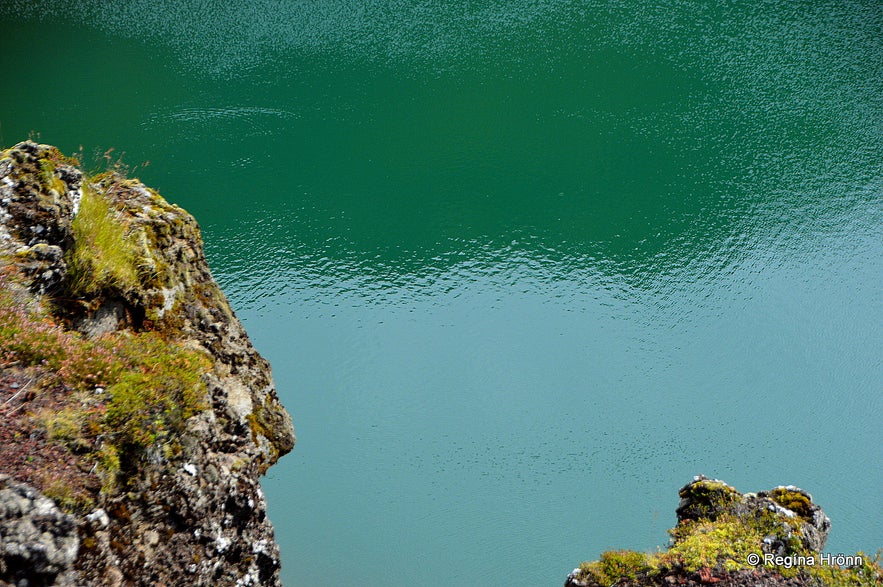 Staring into the green lake at Kerið - I didn't see any movement
Staring into the green lake at Kerið - I didn't see any movement
I found this story in Sagnagrunnur - Furðusýn í Kerinu by Bjarni Harðarson and translated it into English:
"In the last century, 4 or 5 locals from Grímsnes (Grímsnesingar) were rounding up sheep in this area. They were thirsty and out of breath and went down to the lake in Kerið to quench their thirst.
As they were about to drink, they hesitated as a strange sight appeared to them - a myriad of what looked like blind puppies! They didn't appear to have any eyes or legs. They stared at this sight for quite a while.
 People walking down to the lake in Kerið - have they heard these stories?
People walking down to the lake in Kerið - have they heard these stories?
Another such story is when the farmer at Snæfoksstaðir in the vicinity walked down to the lake in Kerið to have a sip of water.
All of a sudden the water started churning and bubbling. He ran for his life away from the crater".
There was a water kelpie sighting in the summer of 1905 in Ölfusá river close to Kerið. The farmer at Kotferja, Hannes Gíslason, saw the water kelpie when he was rowing on the river.
He quickly turned the boat back to land. He described the water kelpie as being a white horse swimming in the river and he could only see the head and the mane of the horse.
Twice the farmer had to abandon his plans on rowing on the river to check on his peat on the western bank of Ölfusá river, Iceland's most voluminous river.
But on his third attempt, he saw that the boat of 2 men from the farm Stóra-Sandvík had capsized and they were in grave danger.
He managed to save them from drowning, so we can say that the water kelpie was inadvertently (or not) instrumental in saving these people. (This account is found in a very thorough and good book I own by Bjarni Harðar - Landið, fólkið og þjóðtrúin, page 73).
 Chilling in a lava bubble on the lookout for water kelpies in Ölfusá river
Chilling in a lava bubble on the lookout for water kelpies in Ölfusá river
There are several such accounts in our folklore and I have heard of another water kelpie in East Iceland. It lives in Nykurhylsfoss waterfall - the Water kelpie falls.
There is even supposed to have been a water kelpie in Reykjavíkurtjörn - the Pond in Reykjavík!
And in 1984 two ptarmigan hunters saw a strange sight in Lake Kleifarvatn on the Reykjanesskagi peninsula, which might have been 2 water kelpies playing in the lake (ref. Tvö skrímsli í Kleifarvatni?).
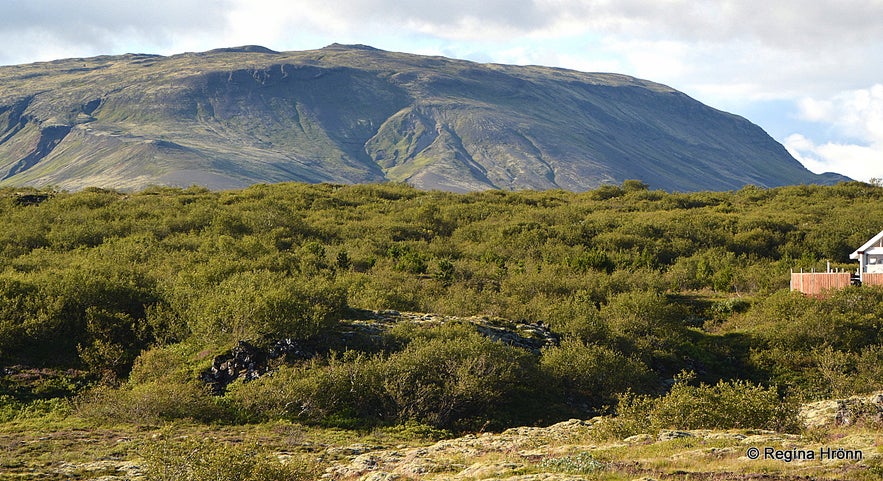 Mt. Búrfell in Grímsnes with the characteristic "Búrfell shape"
Mt. Búrfell in Grímsnes with the characteristic "Búrfell shape"
Mt. Búrfell is not the only mountain in Iceland that goes by this name, as there are 46 mountains or farms that go by the name Búrfell in Iceland - here you can see where they are located - Árnastofnun - Búrfell.
These mountains are characterized by a certain mound shape and look very much alike. Sometimes, if we don't know the name of a mountain, we can guess that it is called Mt. Búrfell, just from its shape.
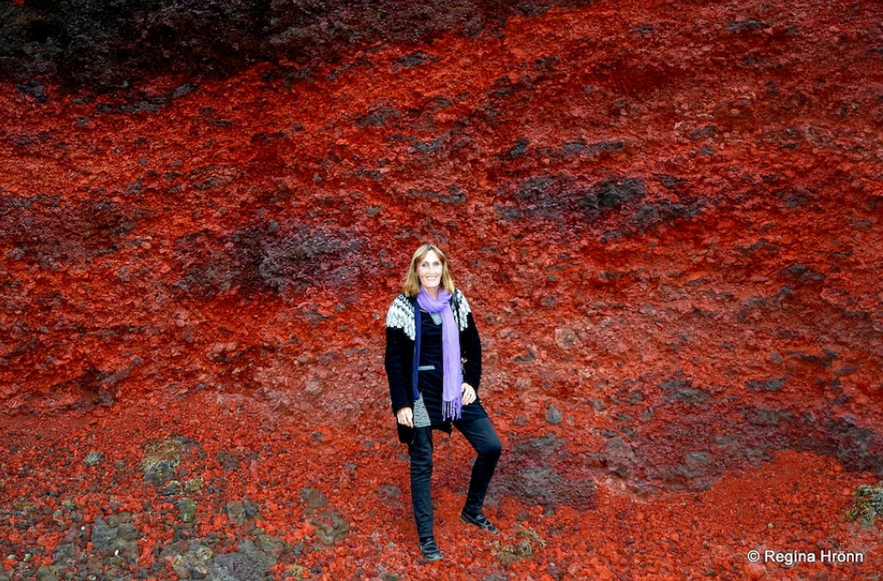
Grímsnes is a very popular summer house area. My grandfather, Kjartan, bought land in Vaðnes in Grímsnes and my family built a summer cottage there. So I have spent a lot of time in this area ever since I was a little girl.
I have very fond memories of this area and Höskuldslækur in Vaðnes is the first creek in which I fished. It joins the Hvítá river, which originates in Langjökull glacier, the second-largest glacier in Iceland.
Hvítá river, in which Gullfoss waterfall cascades down into Hvítárgljúfur gorge, then turns into Ölfusá river a little bit further than in my photo below where Höskuldslækur joins Hvítá river.
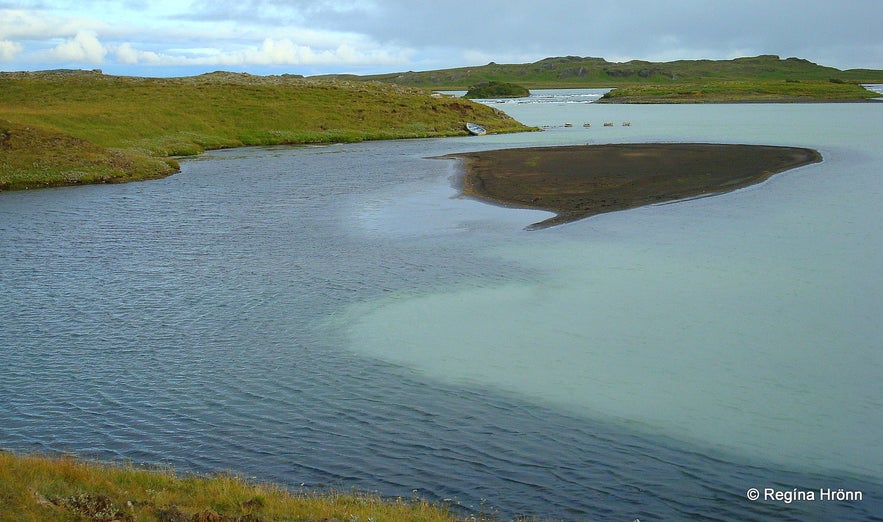 Höskuldslækur creek meets the glacial river Hvítá
Höskuldslækur creek meets the glacial river Hvítá
Kerið is located in Grímsnes, the Peninsula of Grímur. This particular Grímur lived at Grímsnes and the area is named after him.
The settler of this area as described in Landnámabók - the Book of Settlements in Iceland chapter 99, was Grímur who came to Iceland and settled Grímsnes all the way to Lake Svínavatn and lived at Öndurðunes (Öndverðanes) for 4 winters and then moved to Búrfell.
Another well-known settler, Ketilbjörn Ketilsson, settled Grímsnes all the way from Höskuldslækur creek, the whole Laugardalur, and Biskupstungur all the way to Stakksá river - he lived at Mosfell.
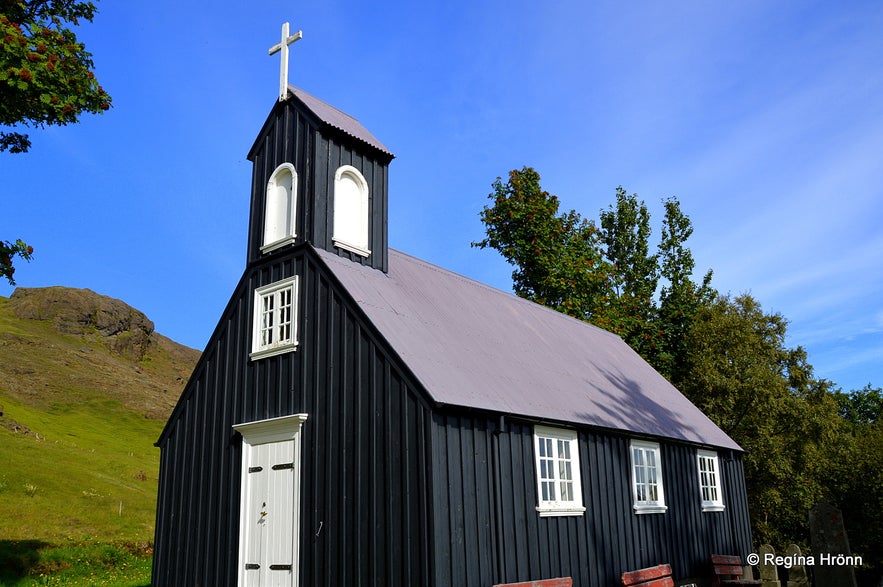 The lovely old Mosfellskirkja church at Mosfell
The lovely old Mosfellskirkja church at Mosfell
Ketilbjörn was my ancestor 29 generations back and his great-grandchild Ísleifur Gissurarson was the first bishop of Iceland at Skálholt episcopal see. The son of Ketilbjörn, Teitur, built the first farm at Skálholt.
When the half-brother of Ketilbjörn, Hallkell, came to Iceland, Ketilbjörn offered to give him a piece of his land. Hallbjörn thought it was demeaning to be given land and demanded a duel with Grímur to get land from him.

I took a photo of the map at Kerið which shows this area
Hallkell killed Grímur in a duel at Hallkelshólar and took his land. Hallkelshólar are close by Seyðishólar craters.
In Landnáma Hallkell is said to be the father of Otkell at Kirkjubæ, one of the characters of Njálssaga, from whom Hallgerður langbrók stole the cheese and Gunnar at Hlíðarendi killed.
Íslendingabók, on the other hand, has listed him as the son of Skarfur, which makes Hallkell the grandfather of Otkell. Njálssaga, in the 47th chapter, confirms that.
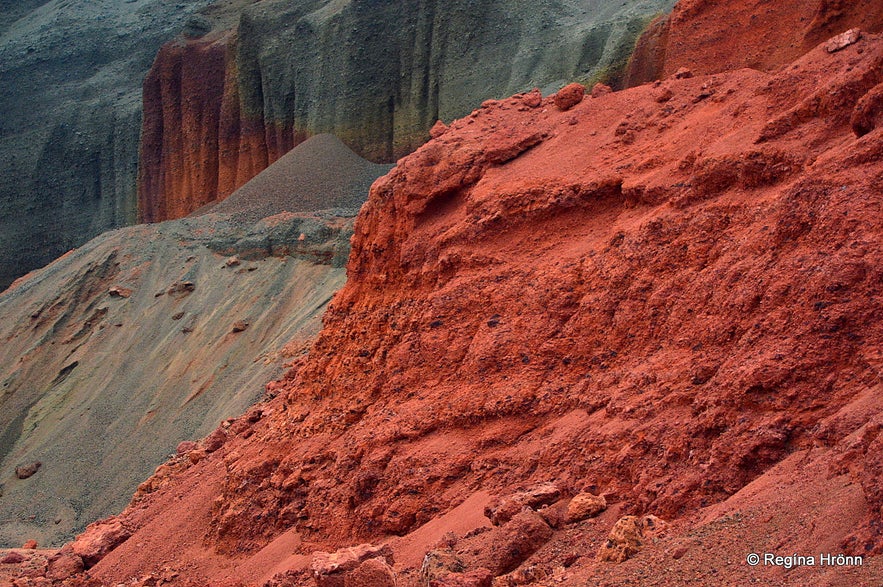 The colourful Seyðishólar craters
The colourful Seyðishólar craters
You will find more craters in Grímsnes, and very prominent are the Seyðishólar row of craters. They are a little bigger than Tjarnarhólar, the biggest ones being Seyðishólar and Kerhóll.
From these craters, 23.5 km2 of the Grímsneshraun lava field originated, the so-called Seyðishólar-Kerhólshraun lava field.
This lava field flowed from 12 volcanoes and covers around 54 km2.
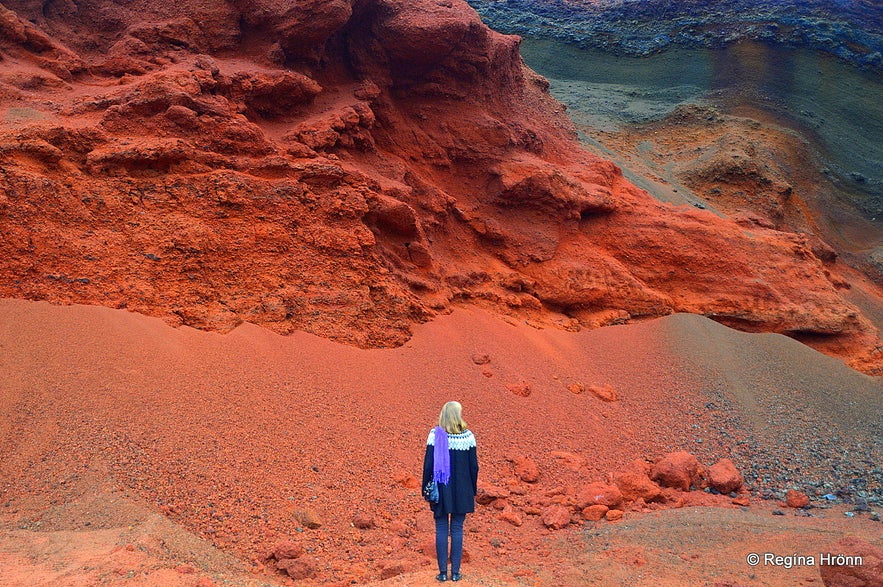 At Seyðishólar crater
At Seyðishólar crater
Seyðishólar sport the most strikingly red colour I have ever seen in a crater. The red colour stems from the oxidation of the iron in the lava.
There is a quarry in that crater which makes this awesome red colour of the lava appear.
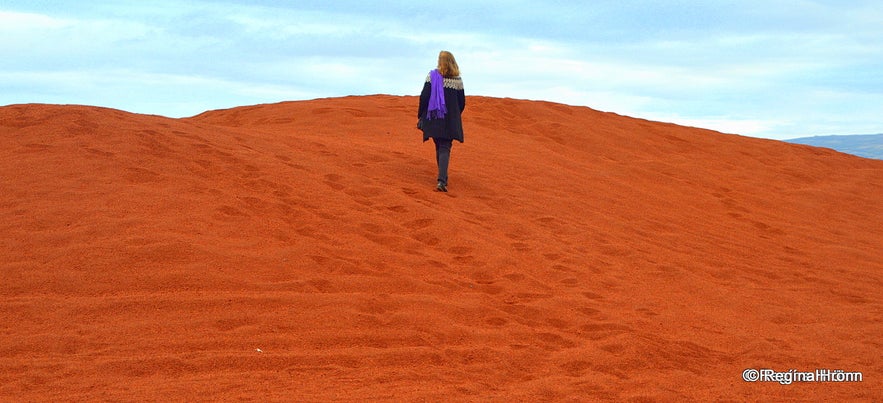 Seyðishólar crater
Seyðishólar crater
There has been a quarry at Seyðishólar for approx. 70 years and last year there were talks about exporting the lava, which means that in the next 15 years, the same amount of lava will be exported as has been removed from the crater for the past 70 years!
I dislike seeing Seyðishólar ruined like this, but on the other hand, I very much like this strikingly red colour which I wouldn't have seen had there not been a quarry opening up the crater.
 Red lava roads in Grímsnes
Red lava roads in Grímsnes
The red lava has been used for the roads in this area and you will notice how pretty the red roads are when you visit this part of Iceland.
The material from the quarry is also used for cinder blocks. The exported lava will be exported to the Nordic countries and used as the base material for growing vegetation on rooftops.
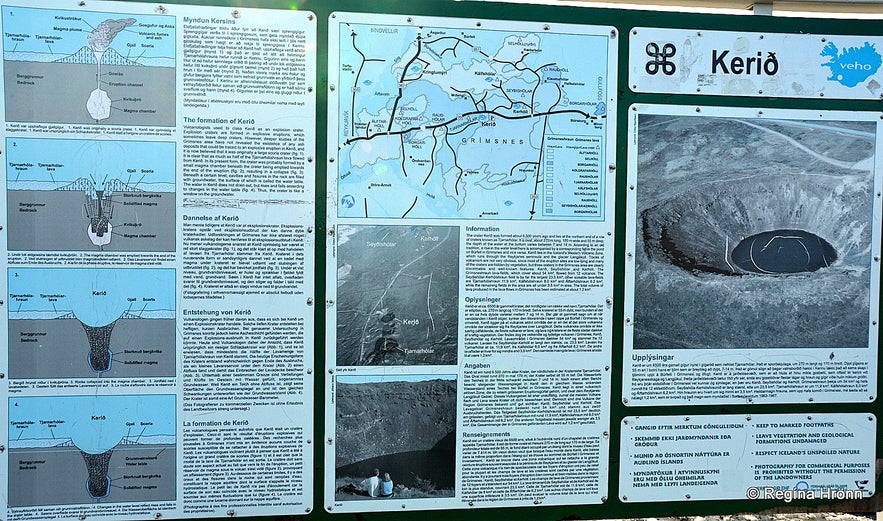 The information sign by Kerið crater
The information sign by Kerið crater
As I have mentioned earlier, then the Kerið crater is a part of the Golden Circle, the most popular day tour in Iceland.
I have written many travel-blogs about the Golden Circle and the beautiful stops on the way. My most recent travel-blog is about a winter visit to the Golden Circle: the Golden Circle in Iceland looks quite magical in the wintertime.
Have a lovely time at Kerið crater :)
Ref.
Landið, fólkið og þjóðtrúin - Bjarni Harðarson
Þjóðsögur Jóns Árnasonar - the Collection of Folklore by Jón Árnason
Otros blogs interesantes
Chasing Waterfalls in Iceland
Iceland is spectacular in so many ways and Icelandic nature is quite unique with its vast landscape, volcanic activity, geothermal areas, glacier lagoons and sceneries, black sand beaches and spectLeer másSænautasel Turf House in the Highland of Iceland
In my search for turf houses around Iceland, I visited Sænautasel, which is a rebuilt turf house on Jökuldalsheiði heath in the highland of Iceland. It is, in my opinion, an extremely cute turf hoLeer másThe Dynamic Plant Lupine
People have been asking me where to find lupines in Iceland. If you like them you should be able to find them easily in Iceland in summer. They are in bloom and visible almost wherever you drive aroLeer más

Descarga la mayor plataforma de viajes a Islandia en tu móvil para gestionar tu viaje al completo desde un solo sitio
Escanea este código QR con la cámara de tu móvil y pulsa en el enlace que aparece para añadir la mayor plataforma de viajes a Islandia a tu bolsillo. Indica tu número de teléfono o dirección de correo electrónico para recibir un SMS o correo electrónico con el enlace de descarga.
